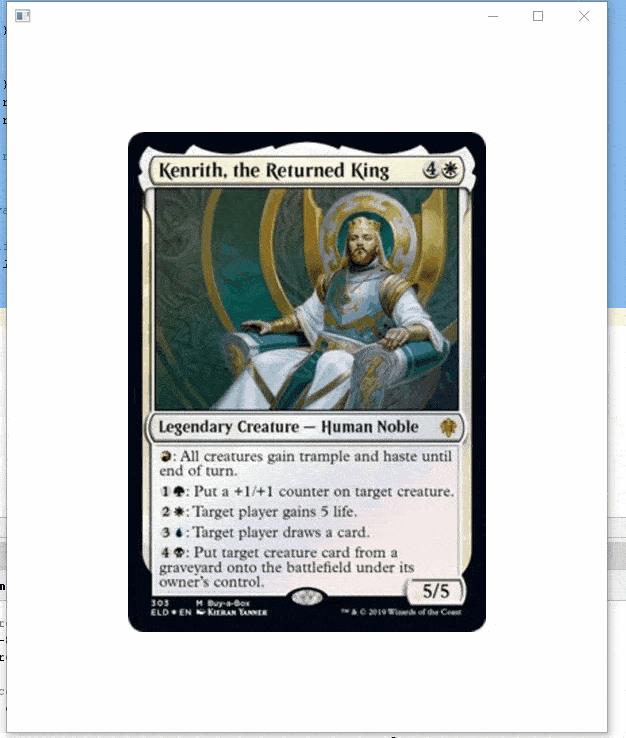I like Sergey's solution, it is such a clever use of ScaleTransition and working in 2D means you don't need to deal with some of the complexities of 3D.
Here a couple of 3D rotation samples.
Rotates a 2D Node (an ImageView) round the Y axis (requires JavaFX 2.2 + 3D support).
import javafx.animation.*;
import javafx.application.Application;
import javafx.scene.*;
import javafx.scene.image.*;
import javafx.scene.layout.StackPane;
import javafx.scene.transform.Rotate;
import javafx.stage.Stage;
import javafx.util.Duration;
public class QuickFlip extends Application {
@Override
public void start(Stage stage) throws Exception {
Node card = createCard();
stage.setScene(createScene(card));
stage.show();
RotateTransition rotator = createRotator(card);
rotator.play();
}
private Scene createScene(Node card) {
StackPane root = new StackPane();
root.getChildren().addAll(card);
Scene scene = new Scene(root, 600, 700, true, SceneAntialiasing.BALANCED);
scene.setCamera(new PerspectiveCamera());
return scene;
}
private Node createCard() {
return new ImageView(
new Image(
"http://www.ohmz.net/wp-content/uploads/2012/05/Game-of-Throne-Magic-trading-cards-2.jpg"
)
);
}
private RotateTransition createRotator(Node card) {
RotateTransition rotator = new RotateTransition(Duration.millis(10000), card);
rotator.setAxis(Rotate.Y_AXIS);
rotator.setFromAngle(0);
rotator.setToAngle(360);
rotator.setInterpolator(Interpolator.LINEAR);
rotator.setCycleCount(10);
return rotator;
}
public static void main(String[] args) {
launch();
}
}
![Daenerys]()
Rotates a 3D Node (a TriangleMesh) round the Y axis (requires Java 8 + 3D support).
import javafx.animation.*;
import javafx.application.Application;
import javafx.scene.*;
import javafx.scene.image.Image;
import javafx.scene.layout.StackPane;
import javafx.scene.paint.*;
import javafx.scene.shape.*;
import javafx.scene.transform.Rotate;
import javafx.stage.Stage;
import javafx.util.Duration;
public class CardFlip extends Application {
final Image CARD_IMAGE = new Image(
"http://fc05.deviantart.net/fs70/i/2010/345/7/7/vitam_et_mortem_by_obviouschild-d34oni2.png"
// sourced from: http://obviouschild.deviantart.com/art/Vitam-et-Mortem-189267194
);
final int W = (int) (CARD_IMAGE.getWidth() / 2);
final int H = (int) CARD_IMAGE.getHeight();
@Override
public void start(Stage stage) throws Exception {
Node card = createCard();
stage.setScene(createScene(card));
stage.show();
RotateTransition rotator = createRotator(card);
rotator.play();
}
private Scene createScene(Node card) {
StackPane root = new StackPane();
root.getChildren().addAll(card, new AmbientLight(Color.WHITE));
Scene scene = new Scene(root, W + 200, H + 200, true, SceneAntialiasing.BALANCED);
scene.setFill(Color.MIDNIGHTBLUE.darker().darker().darker().darker());
scene.setCamera(new PerspectiveCamera());
return scene;
}
private RotateTransition createRotator(Node card) {
RotateTransition rotator = new RotateTransition(Duration.millis(10000), card);
rotator.setAxis(Rotate.Y_AXIS);
rotator.setFromAngle(0);
rotator.setToAngle(360);
rotator.setInterpolator(Interpolator.LINEAR);
rotator.setCycleCount(10);
return rotator;
}
private Node createCard() {
MeshView card = new MeshView(createCardMesh());
PhongMaterial material = new PhongMaterial();
material.setDiffuseMap(CARD_IMAGE);
card.setMaterial(material);
return card;
}
private TriangleMesh createCardMesh() {
TriangleMesh mesh = new TriangleMesh();
mesh.getPoints().addAll(-1 * W/2, -1 * H/2 , 0, 1 * W/2, -1 * H/2, 0, -1 * W/2, 1 * H/2, 0, 1 * W/2, 1 * H/2, 0);
mesh.getFaces().addAll(0, 0, 2, 2, 3, 3, 3, 3, 1, 1, 0, 0);
mesh.getFaces().addAll(0, 4, 3, 7, 2, 6, 3, 7, 0, 4, 1, 5);
mesh.getTexCoords().addAll(0, 0, 0.5f, 0, 0, 1, 0.5f, 1, 0.5f, 0, 1, 0, 0.5f, 1, 1, 1);
return mesh;
}
public static void main(String[] args) {
launch();
}
}
![lightanddark]()



